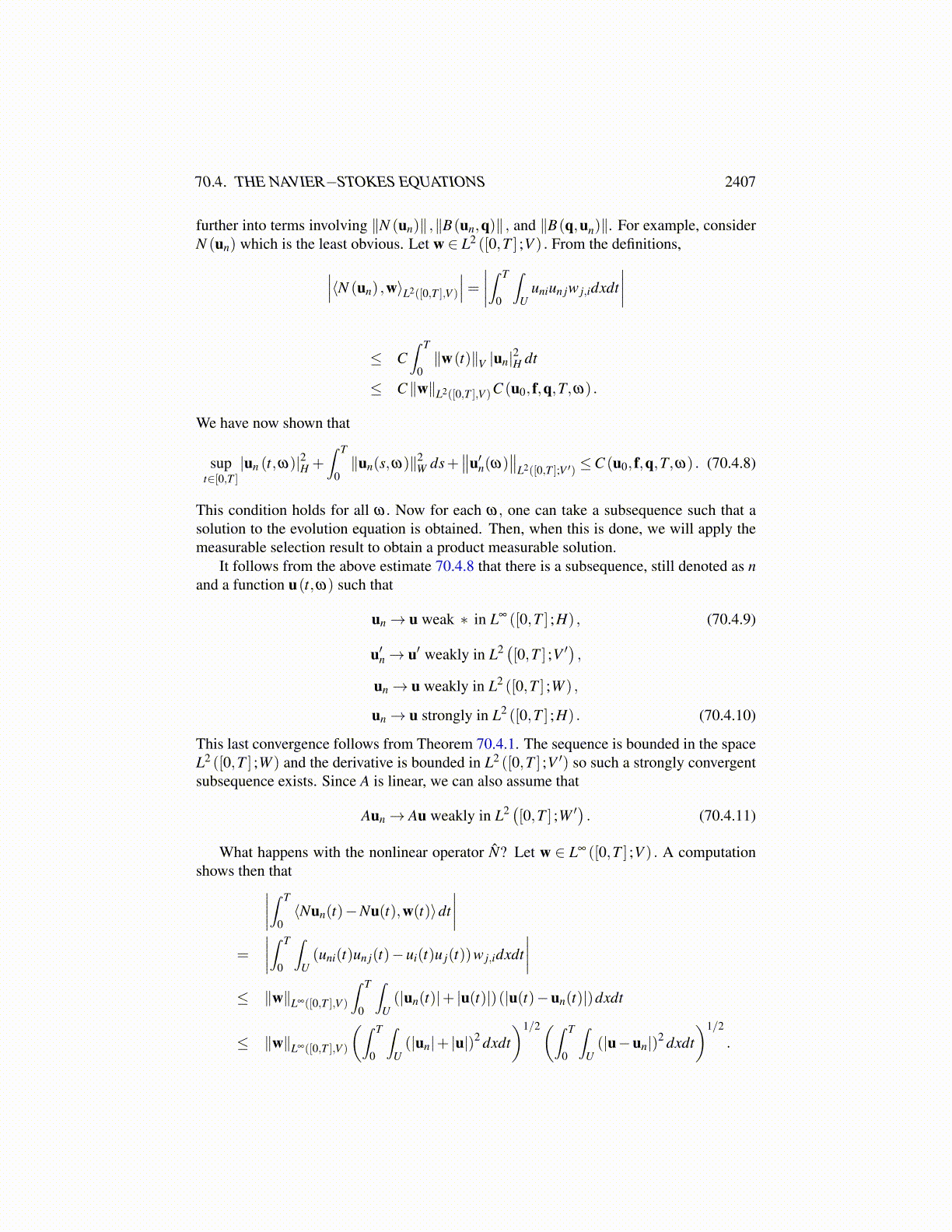
70.4. THE NAVIER−STOKES EQUATIONS 2407
where we have suppressed the dependence of q on ω to simplify the notation. The otherfunction is similar.
As to the claim about product measurability, this follows from the above definition andassumptions about q being product measurable. For the estimates,
|⟨B(w,q) ,z⟩|=∣∣∣∣∫U
wiq jz j,i
∣∣∣∣= ∣∣∣∣∫Uwiq j,iz j
∣∣∣∣≤C∥q∥V∫
U|w| |z|dx,
and apply Hölder’s inequality. The other estimate is similar.This has shown that it suffices to verify that there exists a global solution u to the
equation
u(t,ω)−u0 (ω)+∫ t
0A(u(s,ω))ds+
∫ t
0N̂ (u(s,ω))ds =
∫ t
0f(s,ω)ds,
where f(·,ω) ∈ L2 ([0,T ] ;W ′) for each ω ∈Ω.Let R be the Riesz map from V to V ′, so ⟨Rv1,v2⟩V ′,V = (v1,v2)V for any v1,v2 ∈ V .
The compactness of the embeddings imply that R−1 is a compact self adjoint operator onH and so there is a complete orthonormal basis {wk} for H such that R−1wk = µkwk,where {µk} is a decreasing sequence of positive numbers which converges to 0. ThusRwk = λ kwk, where limk→∞ λ k = ∞. {wk} is a special basis. It is orthonormal in H andorthogonal in V , since (wk,wl)V = ⟨Rwk,wl⟩= (λ kwk,wl)H .
To use the Galerkin method, let Vn = span(w1, · · · ,wn) . Clearly ∪nVn is dense in H.This is also dense in V. If not, then there exists φ ∈ V ′ such that φ ̸= 0 but ∪nVn ⊆ kerφ .Then φ = Ry. Hence for z ∈ ∪M
n=1Vn
0 = ⟨Ry,z⟩= ⟨Rz,y⟩= (Rz,y)H .
But Rz ∈ span(w1, · · · ,wM) and in fact, R maps Vn onto Vn and so this shows that y isperpendicular to span(w1, · · · ,wM) for each M so y = 0 and φ = 0 after all. Thus ∪nVn isalso dense in V and hence it is also dense in W .
Let un (t,ω) = ∑nk=1 xk (t,ω)wk, where x(t,ω) = (x1(t,ω), · · · ,xn(t,ω))T ∈ Rn. We
consider the problem of finding x(t,ω) such that for all wk,k ≤ n,
(un (t,ω) ,wk)H − (u0n (ω) ,wk)H +∫ t
0⟨A(un(s,ω)),wk⟩ds
+∫ t
0
⟨N̂(un(s,ω)),wk
⟩ds =
∫ t
0⟨f(s,ω),wk⟩ds, (70.4.6)
where u0n is the orthogonal projection of u0 onto Vn.By the continuity of the operators described above, and the orthogonality of the wk,
this is nothing but an ordinary differential equation for the vector x(t,ω) . By Theorem70.2.8, there exists a product measurable solution x and therefore, un (t,ω) is also productmeasurable in H.